Exhibitions
2018-1 MOMAT Collection
Date
-Location
Collection Gallery, from the fourth to second floors
The collection exhibition from June 5 – September 24, 2018
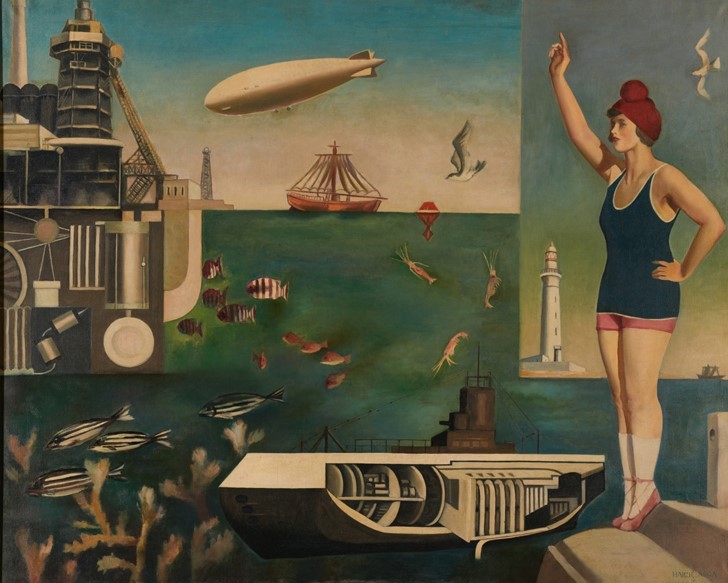
Welcome to the MOMAT Collection! In this exhibition, we introduce currents in Japanese modern and contemporary art from the beginning of the 20th century to the present along with a variety of works from other countries.
In the Highlights section (Room 1, 4th floor), viewers are treated to a host of masterpieces selected from the museum collection. Rooms 2 to 12, arranged in roughly chronological order, have each been assigned a theme, enabling viewers to see the relationship between art and society in each era from a wide range of perspectives. In addition, to commemorate the 150th anniversary of the Meiji Period (1868-1912), a special exhibit called “Art of the Late Meiji Period” is being presented in Room 10 (3rd floor), which is normally devoted to Nihonga (Japanese-style painting). Along with Wada Sanzo’s South Wind, newly designated as an Important Cultural Property this fiscal year, you will find some works from the early Bunten (Ministry of Education Art Exhibition) and others that presage the individualistic artistic expressions that emerged in the Taisho Period (1912-1926). On the second floor, please keep an eye out for a new acquisition by the important postwar American sculptor David Smith. In Gallery 4 (also on the second floor), you will find a small exhibit focusing on the art critic and poet Takiguchi Shuzo. We hope that you will enjoy this edition of the MOMAT Collection, which includes as a wide and varied assortment of works.
translated by Christopher Stephens
List of Works
| room | audio guide (En) | artist | title | 美术家 | 标题 | 작가의 | 표제 | date | on view from | on view to |
|---|---|---|---|---|---|---|---|---|---|---|
| 1 | 0062 | AI-MITSU | Landscape with an Eye | 叆光 | 有眼睛的风景 | 아이미쓰 | 눈이 있는 풍경 | 1938 | 2018/06/05 | 2018/09/24 |
| 1 | UMEHARA, Ryuzaburo | Mt. Sakurajima (Blue) | 梅原龙三郎 | 樱岛(青) | 우메하라 류자브로 | 사쿠라지마(청) | 1935 | 2018/06/05 | 2018/09/24 | |
| 1 | 0012 | OGIWARA, Morie | Woman | 荻原守卫 | 女子 | 오기와라 모리에 | 여자 | 1910 | 2018/06/05 | 2018/09/24 |
| 1 | 0002 | KURODA, Seiki | Dead Leaves | 黑田清辉 | 落叶 | 구로다 세이키 | 낙엽 | 1891 | 2018/06/05 | 2018/09/24 |
| 1 | 0040 | KOGA, Harue | Sea | 古贺春江 | 海 | 고가 하루에 | 바다 | 1929 | 2018/06/05 | 2018/09/24 |
| 1 | 0029 | NAKAMURA, Tsune | Portrait of Vasilii Yaroshenko | 中村彝 | 愛羅先珂先生的肖像 | 나카무라 쓰네 | 예로센코의 초상 | 1920 | 2018/06/05 | 2018/09/24 |
| 1 | 0001 | HARADA, Naojiro | Kannon Bodhisattva Riding the Dragon | 原田直次郎 | 骑龙观音 | 하라다 나오지로 | 기용 관음 | 1890 | 2018/06/05 | 2018/09/24 |
| 1 | Matsumoto Shunsuke | Scene near N Station | 松本竣介 | N车站附近 | 마쓰모토 슌스케 | N역 근처 | 1940 | 2018/06/05 | 2018/09/24 | |
| 1 | 0052 | YASUI, Sotaro | Portrait of Chin-Jung | 安井曾太郎 | 金蓉 | 야스이 소타로 | 진중의 초상 | 1934 | 2018/06/05 | 2018/09/24 |
| 1 | KABURAKI, Kiyokata | Monthly Manners and Customs of the Meiji Period, January | 镝木清方 | 明治风俗十二月 | 가부라키 기요카타 | 메이지 세시 풍속 | 1935 | 2018/06/05 | 2018/07/29 | |
| 1 | 0047 | KAWABATA, Ryushi | Flaming Grass | 川端龙子 | 草炎 | 가와바타 류시 | 초염(草炎) | 1930 | 2018/07/31 | 2018/09/24 |
| 1 | KOBAYASHI, Kokei | Indian Corn Plants | 小林古径 | 玉米 | 고바야시 고케이 | 옥수수 | 1939 | 2018/07/31 | 2018/09/24 | |
| 2 | KOGA, Harue | Thinking Woman | 古贺春江 | 思考的女人 | 고가 하루에 | 생각하는 여인 | 1919 | 2018/06/05 | 2018/09/24 | |
| 2 | SEKINE, Shoji | Portrait of a Woman | 关根正二 | 妇人像 | 세키네 쇼지 | 부인상 | c.1918 | 2018/06/05 | 2018/09/24 | |
| 2 | 0027 | SEKINE, Shoji | Three Stars | 关根正二 | 三星 | 세키네 쇼지 | 삼형제 별 | 1919 | 2018/06/05 | 2018/09/24 |
| 2 | 0025 | TAKAMURA, Kotaro | Hand | 高村光太郎 | 手 | 다카무라 고타로 | 손 | c.1918 | 2018/06/05 | 2018/09/24 |
| 2 | NAKAGAWA, Kazumasa | Landscape at Itabashi | 中川一政 | 板桥风景 | 나카가와 가즈마사 | 이타바시 풍경 | 1919 | 2018/06/05 | 2018/09/24 | |
| 2 | FUJISHIMA, Takeji | Artichoke | 藤岛武二 | 洋蓟花 | 후지시마 다케지 | 아르티쇼 | 1917 | 2018/06/05 | 2018/09/24 | |
| 2 | 0021 | MURAYAMA, Kaita | Roses and a Girl | 村山槐多 | 玫瑰和少女 | 무라야마 가이타 | 장미와 소녀 | 1917 | 2018/06/05 | 2018/09/24 |
| 2 | YOROZU, Tetsugoro | Landscape with Standing Trees | 万铁五郎 | 树木风景 | 요로즈 데쓰고로 | 나무가 서 있는 풍경 | 1916 | 2018/06/05 | 2018/09/24 | |
| 2 | KAWABATA, Ryushi | Divine Light of Love: Morning, Evening | 川端龙子 | 慈悲光礼赞(朝、夕) | 가와바타 류시 | 자비의 빛의 예찬(아침, 저녁) | 1918 | 2018/06/05 | 2018/07/29 | |
| 2 | KIKKAWA, Reika | Virgin at Mt. Hakoya | 吉川灵华 | 藐姑射之处子 | 깃카와 레이카 | 막고야산의 처자 | 1918 | 2018/06/05 | 2018/07/29 | |
| 2 | HAYAMI, Gyoshu | Early Spring | 速水御舟 | 浅春 | 하야미 교슈 | 초봄 | 1918 | 2018/06/05 | 2018/07/29 | |
| 2 | 0026 | TSUCHIDA, Bakusen | Serving Girl in a Spa | 土田麦僊 | 澡堂侍女 | 쓰치다 바쿠센 | 온천에서 일하는 여자 | 1918 | 2018/07/31 | 2018/09/24 |
| 2 | TSUCHIDA, Bakusen | Sketchbook | 土田麦僊 | 画册 | 쓰치다 바쿠센 | 스케치북 | c.1918 | 2018/07/31 | 2018/09/24 | |
| 2 | TSUCHIDA, Bakusen | Sketch for Serving Girl in a Spa | 土田麦僊 | 《澡堂侍女》 写生 | 쓰치다 바쿠센 | 「온천에서 일하는 여자」 사생 | c.1918 | 2018/07/31 | 2018/09/24 | |
| 2 | TSUCHIDA, Bakusen | Sketch for Serving Girl in a Spa | 土田麦僊 | 《澡堂侍女》 写生 | 쓰치다 바쿠센 | 「온천에서 일하는 여자」 사생 | c.1918 | 2018/07/31 | 2018/09/24 | |
| 3 | IHARA, Usaburo | Group in a Room | 伊原宇三郎 | 室内群像 | 이하라 우사부로 | 실내 군상 | 1928-29 | 2018/06/05 | 2018/09/24 | |
| 3 | KAWAGUCHI, Kigai | Still Life, Mandolin | 川口轨外 | 静物(曼陀林) | 가와구치 기가이 | 정물(만돌린) | 1927-31 | 2018/06/05 | 2018/09/24 | |
| 3 | KOJIMA, Zentaro | Man Playing the Violin | 小岛善太郎 | 拉小提琴的男人 | 고지마 젠타로 | 바이올린 켜는 남자 | 1932 | 2018/06/05 | 2018/09/24 | |
| 3 | 0039 | SAEKI, Yuzo | Gas Lamp and Advertisements | 佐伯祐三 | 煤气灯和广告 | 사에키 유조 | 가스등과 광고 | 1927 | 2018/06/05 | 2018/09/24 |
| 3 | SAEKI, Yuzo | Church at Morin | 佐伯祐三 | 莫兰的教堂 | 사에키 유조 | 모랭의 교회 | 1928 | 2018/06/05 | 2018/09/24 | |
| 3 | SATOMI, Katsuzo | Still Life | 里见胜藏 | 静物 | 사토미 가쓰조 | 정물 | 1926 | 2018/06/05 | 2018/09/24 | |
| 3 | SATOMI, Katsuzo | Interior (Woman) | 里见胜藏 | 室内(女) | 사토미 가쓰조 | 실내(여) | 1927 | 2018/06/05 | 2018/09/24 | |
| 3 | NOGUCHI, Yataro | Bellecour Place | 野口弥太郎 | 白莱果广场 | 노구치 야타로 | 벨쿠르 광장 | 1931 | 2018/06/05 | 2018/09/24 | |
| 3 | MAETA, Kanji | Nude | 前田宽治 | 裸妇 | 마에타 간지 | 나부 | 1925 | 2018/06/05 | 2018/09/24 | |
| 3 | MAETA, Kanji | Woman in Black | 前田宽治 | 黑衣妇人像 | 마에타 간지 | 검은 옷의 부인상 | 1925 | 2018/06/05 | 2018/09/24 | |
| 4 | KOIZUMI, Kishio | From One Hundred Scenes from the Tokyo Metropolis in the Showa Period | 小泉癸巳男 | 出自《昭和大东京百图绘》 | 고이즈미 기시오 | 《쇼와시대 도쿄의 백가지 풍경》에서 | 2018/06/05 | 2018/09/24 | ||
| 4 | No.3: Mitsui Building and Mitsukoshi Department Store | 3.三井和三越 | 3. 미쓰이와 미쓰코시 | 1929 | 2018/06/05 | 2018/07/29 | ||||
| 4 | No.4: Oil Tanks in Senju | 4.千住油罐街 | 4. 센주 가스 탱크 거리 | 1930 | 2018/06/05 | 2018/07/29 | ||||
| 4 | No.5: Young Leaves and Azaleas in Hibiya Park | 5.新绿与日比谷公园的杜鹃花 | 5. 신록과 히비야 공원의 철쭉 | 1930 | 2018/06/05 | 2018/07/29 | ||||
| 4 | No.16: Vegetable Market in Kanda | 16.神田菜市场 | 16. 간다의 청과물 시장 | 1931 | 2018/06/05 | 2018/07/29 | ||||
| 4 | No.20: The Ferry at Kachidoki, Tsukiji | 20.筑地,胜哄桥 | 20. 쓰키지 가치도키의 나루터 | 1931 | 2018/06/05 | 2018/07/29 | ||||
| 4 | No.25: Sumida Park in Kototoi, Mukojima | 25.墨田公园向岛言问 | 25. 무코지마 고토토이의 스미다 공원 | 1932 | 2018/06/05 | 2018/07/29 | ||||
| 4 | No.30: Hijiri Bridge | 30.圣桥 | 30. 히지리바시 | 1932 | 2018/06/05 | 2018/07/29 | ||||
| 4 | No.54: Landscape in Sunamachi Town, Joto Ward | 54.城东区砂町风景 | 54. 조토구 스나마치 풍경 | 1934 | 2018/06/05 | 2018/07/29 | ||||
| 4 | No.59: Kokugikan Arena During the Spring Sumo Tournament | 59.春场所的国技馆 | 59. 봄경기 국기장 | 1935 | 2018/06/05 | 2018/07/29 | ||||
| 4 | No.64: Pine Tree at the Zen’yo-ji Temple in Edogawa Ward | 64.江户川区,善养寺的星降松 | 64. 에도가와구 젠요지의 소나무 | 1935 | 2018/06/05 | 2018/07/29 | ||||
| 4 | No.66: River Festival at Ryogoku | 66.两国的开川祭 | 66. 료고쿠의 가와비라키 불꽃놀이 | 1936 | 2018/06/05 | 2018/07/29 | ||||
| 4 | No.87: The International Airport, Haneda | 87.羽田国际机场 | 87. 하네다 국제 비행장 | 1937 | 2018/06/05 | 2018/07/29 | ||||
| 4 | No.90: Hyokeikan Hall and the Museum, Ueno | 90.上野风景,表庆馆和美术馆 | 90. 우에노 풍경, 효케이관과 미술관 | 1937 | 2018/06/05 | 2018/07/29 | ||||
| 4 | No.6: The Drawbridge on the Rinkai Pier, Shibaura | 6.芝浦临海码头可动桥 | 6. 시바우라 린카이 부두 도개교 | 1930 | 2018/07/31 | 2018/09/24 | ||||
| 4 | No.12: Spring Night on Ginza | 12.春日银座夜景 | 12. 봄의 긴자 야경 | 1931 | 2018/07/31 | 2018/09/24 | ||||
| 4 | No.15: Sekiguchi, Otaki | 15.关口,大泷 | 15. 세키구치의 오타키 | 1931 | 2018/07/31 | 2018/09/24 | ||||
| 4 | No.33: Earthquake Memorial Hall in Honjo | 33.本所,震灾纪念堂 | 33. 혼죠의 진재기념당 | 1932 | 2018/07/31 | 2018/09/24 | ||||
| 4 | No.39: Garbage Incineration Plant in Fukagawa | 39.东京深川垃圾处理工场 | 39. 도쿄 후쿠가와 쓰레기 처리 공장 | 1933 | 2018/07/31 | 2018/09/24 | ||||
| 4 | No.47: Steamship Landing and Bridges | 47.轮船客运站和桥的风景 | 47. 기선 정류장과 다리 | 1934 | 2018/07/31 | 2018/09/24 | ||||
| 4 | No.58: Tokyo Chrysanthemum Show at Hibiya Park | 58.日比谷公园,东京市菊花大会 | 58. 히비야 공원의 도쿄시 국화 대회 | 1934 | 2018/07/31 | 2018/09/24 | ||||
| 4 | No.60: At the Foot of Sukiyabashi Bridge | 60.数寄屋桥畔 | 60. 스키야바시 부근 | 1935 | 2018/07/31 | 2018/09/24 | ||||
| 4 | No.61: Buildings in Shinjuku | 61.淀桥区新宿街景 | 61. 요도바시구 신주쿠 거리 | 1935 | 2018/07/31 | 2018/09/24 | ||||
| 4 | No.76: Tokyo Municipal Hall | 76.东京市政府 | 76. 도쿄시청 | 1936 | 2018/07/31 | 2018/09/24 | ||||
| 4 | No.100: Kabutocho Stock Exchange | 100.兜町,交易所街 | 100. 가부토초 거래소 거리 | 1937 | 2018/07/31 | 2018/09/24 | ||||
| 4 | No.27 (new version): Togoshi Ginza Station | 改版27.户越银座,荏原区 | 개정판 27. 에바라구 도고시 긴자 | 1940 | 2018/07/31 | 2018/09/24 | ||||
| 4 | No.20 (new version): Kachidoki Bridge | 改版20.胜哄桥 | 개정판 20. 가치도키바시 | Date unknown | 2018/07/31 | 2018/09/24 | ||||
| 5 | AI-MITSU | Lion | 叆光 | 狮子 | 아이미쓰 | 사자 | 1936 | 2018/06/05 | 2018/09/24 | |
| 5 | ASAKURA, Fumio | Looking Up | 朝仓文夫 | 仰视 | 아사쿠라 후미오 | 앙시 | 1944 | 2018/06/05 | 2018/09/24 | |
| 5 | INOKUMA, Gen’ichiro | Railroad Construction in a Certain Area | 猪熊弦一郎 | ○○方向的铁道建设 | 이노쿠마 겐이치로 | ○○방면 철도 건설 | 1944 | 2018/06/05 | 2018/09/24 | |
| 5 | SUDA, Kunitaro | Walking Eagle | 须田国太郎 | 行走的鹫 | 스다 구니타로 | 걷는 독수리 | 1940 | 2018/06/05 | 2018/09/24 | |
| 5 | KITAWAKI, Noboru | Airport | 北胁升 | 机场 | 기타와키 노보루 | 공항 | 1937 | 2018/06/05 | 2018/09/24 | |
| 5 | KOMAKI, Gentaro | Bricks and a Squirrel | 小牧源太郎 | 积木和松鼠 | 고마키 겐타로 | 나무 블록과 다람쥐 | 1941 | 2018/06/05 | 2018/09/24 | |
| 5 | FUKUZAWA, Ichiro | Oxen | 福泽一郎 | 牛 | 후쿠자와 이치로 | 소 | 1936 | 2018/06/05 | 2018/09/24 | |
| 5 | FUJIO, Ryushiro | Mythos, Study for Figures | 藤尾龙四郎 | 神话(群像习作) | 후지오 류시로 | 신화(군상 습작) | 1943 | 2018/06/05 | 2018/09/24 | |
| 5 | YAMASHITA, Kikuji | Salmon and Owl | 山下菊二 | 鲑与枭 | 야마시타 기쿠지 | 연어와 올빼미 | 1939 | 2018/06/05 | 2018/09/24 | |
| 5 | WADA, Sanzo | Mandara for Rousing Asians | 和田三造 | 兴亚曼荼罗 | 와다 산조 | 흥아 만다라 | 1940 | 2018/06/05 | 2018/09/24 | |
| 6 | ASO, Saburo | Red Sky | 麻生三郎 | 赤空 | 아소 사부로 | 붉은 하늘 | 1956 | 2018/06/05 | 2018/09/24 | |
| 6 | EBIHARA, Kinosuke | Rainy Day | 海老原喜之助 | 雨天 | 에비하라 기노스케 | 비오는 날 | 1963 | 2018/06/05 | 2018/09/24 | |
| 6 | OYAMADA, Jiro | Dining Table | 小山田二郎 | 餐桌 | 오야마다 지로 | 식탁 | 1955 | 2018/06/05 | 2018/09/24 | |
| 6 | KAZUKI, Yasuo | Carrier | 香月泰男 | 搬运的人 | 가즈키 야스오 | 나르는 사람 | 1959 | 2018/06/05 | 2018/09/24 | |
| 6 | SUGURO, Tadashi | Heavy Moon | 胜吕忠 | 重月 | 스구로 다다시 | 무거운 달 | 1956 | 2018/06/05 | 2018/09/24 | |
| 6 | TATEHATA, Kakuzo | Figure | 建畠觉造 | 貌 | 다테하타 가쿠조 | 얼굴 | 1955 | 2018/06/05 | 2018/09/24 | |
| 6 | NAKANO, Jun | Dining Table | 中野淳 | 餐桌 | 나카노 준 | 식탁 | 1956 | 2018/06/05 | 2018/09/24 | |
| 6 | FURUSAWA, Iwami | Mountain Path | 古泽岩美 | 垭口 | 후루사와 이와미 | 고개 | 1952 | 2018/06/05 | 2018/09/24 | |
| 6 | ASO, Saburo | Lying Man | 麻生三郎 | 躺着的男人 | 아소 사부로 | 자고 있는 남자 | 1963 | 2018/06/05 | 2018/07/29 | |
| 6 | ISHII, Shigeo | People of the Nest | 石井茂雄 | 巢中的人们 | 이시이 시게오 | 둥지의 사람들 | 1959 | 2018/06/05 | 2018/07/29 | |
| 6 | ISHII, Shigeo | Prisoner | 石井茂雄 | 虏囚 | 이시이 시게오 | 포로 | 1961 | 2018/06/05 | 2018/07/29 | |
| 6 | HAMADA, Chimei | Crowd of the Blind | 滨田知明 | 群盲 | 하마다 지메이 | 군맹(群盲) | 1960 | 2018/06/05 | 2018/07/29 | |
| 6 | ASO, Saburo | Eye C | 麻生三郎 | 目C | 아소 사부로 | 눈 C | 1967 | 2018/07/31 | 2018/09/24 | |
| 6 | KAWARA, On | Dump | 河原温 | 垃圾场 | 가와라 온 | 쓰레기장 | 1954 | 2018/07/31 | 2018/09/24 | |
| 6 | HAMADA, Chimei | Elegy of Raw Recruits: Sentinel | 滨田知明 | 初年兵哀歌(步哨) | 하마다 지메이 | 초년병 애가(보초) | 1951 | 2018/07/31 | 2018/09/24 | |
| 6 | HAMADA, Chimei | Landscape | 滨田知明 | 风景 | 하마다 지메이 | 풍경 | 1953 | 2018/07/31 | 2018/09/24 | |
| 7 | Bruce Nauman | Bouncing in the Corner No.1 | 布鲁斯·瑙曼 | 角落跳跃No.1 | 브루스 나우만 | 코너에서 바운싱 No.1 | 1968 | 2018/06/05 | 2018/09/24 | |
| 7 | Hergé (Georges Remi) | No.43 from Flight 714 to Sydney | 埃尔热(乔治·勒米) | 《714航班》之No.43 | 에르제(조르주 레미) | “시드니행 714편” 중 No.43 | 1968/81 | 2018/06/05 | 2018/09/24 | |
| 7 | KAMOI, Rei | Stand Still Time | 鸭居玲 | 静止之刻 | 가모이 레이 | 정지한 시간 | 1968 | 2018/06/05 | 2018/09/24 | |
| 7 | KOJIMA, Nobuaki | Boxer | 小岛信明 | 拳击选手 | 고지마 노부아키 | 복서 | 1968 | 2018/06/05 | 2018/09/24 | |
| 7 | TOMATSU, Shomei | From Castle | 东松照明 | 出自《城》 | 도마쓰 쇼메이 | “성”에서 | 1968 (1992 print) | 2018/06/05 | 2018/09/24 | |
| 7 | NAKANISHI, Natsuyuki | Compact Object: Sinking Scissors | 中西夏之 | 小型作品 沉没的剪刀 | 나카니시 나쓰유키 | 콤팩트 오브제 가라앉는 가위 | 1968 | 2018/06/05 | 2018/09/24 | |
| 7 | HOSHINO, Shingo | White Work, Man | 星野真吾 | 白色作品,男 | 호시노 신고 | 하얀 작품・남자 | 1968 | 2018/06/05 | 2018/09/24 | |
| 7 | MOKUTA, Takeo | Notification | 杢田武雄 | 告知 | 모쿠타 다케오 | 고지 | 1968 | 2018/06/05 | 2018/09/24 | |
| 7 | WATANABE, Katsumi | Barkers, Shinjuku | 渡边克巳 | 揽客的人,新宿 | 와타나베 가쓰미 | 선전원, 신주쿠 | 1968 (2014 print) | 2018/06/05 | 2018/09/24 | |
| 7 | WATANABE, Katsumi | Bandsmen, Shinjuku | 渡边克巳 | 乐队小子,新宿 | 와타나베 가쓰미 | 밴드 보이, 신주쿠 | 1968 (c.2005 print) | 2018/06/05 | 2018/09/24 | |
| 7 | Barbara Hepworth | Four Figures Waiting | 芭芭拉·赫普沃斯 | 等待的四个人 | 헵워스 바버라 | 4 명의 피규어 대기 중 | 1968 | 2018/06/05 | 2018/09/24 | |
| 7 | TAMURA, Akihide | Yokota from BASE | 田村彰英 | 《BASE》之“横田” | 다무라 아키히데 | “BASE”에서 요코타 | 1968 (printed later) | 2018/06/05 | 2018/07/29 | |
| 7 | TAMURA, Akihide | Yokota from BASE | 田村彰英 | 《BASE》之“横田” | 다무라 아키히데 | “BASE”에서 요코타 | 1968 (1992 print) | 2018/06/05 | 2018/07/29 | |
| 7 | TAMURA, Akihide | Yokota from BASE | 田村彰英 | 《BASE》之“横田” | 다무라 아키히데 | “BASE”에서 요코타 | 1968 (1992 print) | 2018/07/31 | 2018/09/24 | |
| 7 | TAMURA, Akihide | Yokota from BASE | 田村彰英 | 《BASE》之“横田” | 다무라 아키히데 | “BASE”에서 요코타 | 1968 (1992 print) | 2018/07/31 | 2018/09/24 | |
| 8 | ISHIUCHI, Miyako | Yasuura from Endless Night | 石内都 | 《连夜之街》之“安浦” | 이시우치 미야코 | “연야의 거리”에서 야스우라 | 1978-80 (1993 print) | 2018/06/05 | 2018/09/24 | |
| 8 | ISHIUCHI, Miyako | Nakamura Red-light District from Endless Night | 石内都 | 《连夜之街》之“中村游廓” | 이시우치 미야코 | “연야의 거리”에서 나카무라 유곽 | 1978-80 (1993 print) | 2018/06/05 | 2018/09/24 | |
| 8 | ISHIUCHI, Miyako | Tobita-Shinchi from Endless Night | 石内都 | 《连夜之街》之“飞天新地” | 이시우치 미야코 | “연야의 거리”에서 도비타 신치 | 1978-80 (1993 print) | 2018/06/05 | 2018/09/24 | |
| 8 | ISHIUCHI, Miyako | Miyagawa-Cho from Endless Night | 石内都 | 《连夜之街》之“宫川町” | 이시우치 미야코 | “연야의 거리”에서 미야가와초 | 1978-80 (1993 print) | 2018/06/05 | 2018/09/24 | |
| 8 | ISHIUCHI, Miyako | Noge from Endless Night | 石内都 | 《连夜之街》之“野毛” | 이시우치 미야코 | “연야의 거리”에서 노게 | 1978-80 (1993 print) | 2018/06/05 | 2018/09/24 | |
| 8 | KATSURA, Yuki (Yukiko) | Work | 桂雪(雪子) | 作品 | 가쓰라 유키(유키코) | 작품 | 1978-79 | 2018/06/05 | 2018/09/24 | |
| 8 | KANNO, Seiko | Work | 菅野圣子 | 作品 | 간노 세이코 | 작품 | c.1970 | 2018/06/05 | 2018/09/24 | |
| 8 | KANNO, Seiko | Eulogy on Vowels 4 | 菅野圣子 | 母音颂4 | 간노 세이코 | 모음송(母音頌) 4 | 1973 | 2018/06/05 | 2018/09/24 | |
| 8 | KINOSHITA, Kazuyo | ’79-38-A | 木下佳通代 | 79-38-A | 기노시타 가즈요 | 79-38-A | 1979 | 2018/06/05 | 2018/09/24 | |
| 8 | KINOSHITA, Kazuyo | Compass ’77-I | 木下佳通代 | 圆规’77-I | 기노시타 가즈요 | 컴퍼스 ’77-I | 1977 | 2018/06/05 | 2018/09/24 | |
| 8 | KINOSHITA, Kazuyo | ’79-40-A | 木下佳通代 | ’79-40-A | 기노시타 가즈요 | ’79-40-A | 1979 | 2018/06/05 | 2018/09/24 | |
| 8 | SAKAGAMI, Chiyuki | Untitled | 坂上Chiyuki | 无题 | 사카가미 지유키 | 무제 | c.1980 | 2018/06/05 | 2018/09/24 | |
| 8 | SAKAGAMI, Chiyuki | Untitled | 坂上Chiyuki | 无题 | 사카가미 지유키 | 무제 | c.1980 | 2018/06/05 | 2018/09/24 | |
| 8 | SAKAGAMI, Chiyuki | Untitled | 坂上Chiyuki | 无题 | 사카가미 지유키 | 무제 | c.1980 | 2018/06/05 | 2018/09/24 | |
| 8 | SAKAGAMI, Chiyuki | In Search of the Supernatural 7 | 坂上Chiyuki | 搜神7 | 사카가미 지유키 | 수신(捜神) 7 | 1984 | 2018/06/05 | 2018/09/24 | |
| 8 | SAKAGAMI, Chiyuki | Frozen King | 坂上Chiyuki | 冰冻王者 | 사카가미 지유키 | 얼어 붙은 왕 | 1982 | 2018/06/05 | 2018/09/24 | |
| 8 | SAKAGAMI, Chiyuki | Untitled | 坂上Chiyuki | 无题 | 사카가미 지유키 | 무제 | c.1982 | 2018/06/05 | 2018/09/24 | |
| 8 | TATSUNO, Toeko | UNTITLED-35 | 辰野登惠子 | UNTITLED-35 | 다쓰노 도에코 | UNTITLED-35 | 1974 | 2018/06/05 | 2018/09/24 | |
| 8 | TATSUNO, Toeko | UNTITLED-24 | 辰野登惠子 | UNTITLED-24 | 다쓰노 도에코 | UNTITLED-24 | 1974 | 2018/06/05 | 2018/09/24 | |
| 8 | TATSUNO, Toeko | UNTITLED-28 | 辰野登惠子 | UNTITLED-28 | 다쓰노 도에코 | UNTITLED-28 | 1974 | 2018/06/05 | 2018/09/24 | |
| 8 | MIYAWAKI, Aiko | Scroll Painting, White | 宫胁爱子 | 卷轴画,白 | 미야와키 아이코 | 두루마리 그림, 백 | 1975 | 2018/06/05 | 2018/09/24 | |
| 8 | MIYAWAKI, Aiko | Scroll Painting, Black | 宫胁爱子 | 卷轴画,黑 | 미야와키 아이코 | 두루마리 그림, 흑 | 1976 | 2018/06/05 | 2018/09/24 | |
| 9 | YAMAMURA, Gasho | From Plants | 山村雅昭 | 出自《植物》 | 야마무라 가쇼 | ‘식물에’로부터 | 1974-75 | 2018/06/05 | 2018/07/29 | |
| 9 | YAMAMURA, Gasho | From Plants | 1974-75 | 2018/06/05 | 2018/07/29 | |||||
| 9 | YAMAMURA, Gasho | From Plants | 1974-75 | 2018/06/05 | 2018/07/29 | |||||
| 9 | YAMAMURA, Gasho | From Plants | 1974-75 | 2018/06/05 | 2018/07/29 | |||||
| 9 | YAMAMURA, Gasho | From Plants | 1974-75 | 2018/06/05 | 2018/07/29 | |||||
| 9 | YAMAMURA, Gasho | From Plants | 1974-75 | 2018/06/05 | 2018/07/29 | |||||
| 9 | YAMAMURA, Gasho | From Plants | 1974-75 | 2018/06/05 | 2018/07/29 | |||||
| 9 | YAMAMURA, Gasho | From Plants | 1974-75 | 2018/06/05 | 2018/07/29 | |||||
| 9 | YAMAMURA, Gasho | From Plants | 1974-75 | 2018/06/05 | 2018/07/29 | |||||
| 9 | YAMAMURA, Gasho | From Plants | 1974-75 | 2018/06/05 | 2018/07/29 | |||||
| 9 | YAMAMURA, Gasho | From Plants | 1974-75 | 2018/06/05 | 2018/07/29 | |||||
| 9 | YAMAMURA, Gasho | From Plants | 1974-75 | 2018/06/05 | 2018/07/29 | |||||
| 9 | YAMAMURA, Gasho | From Plants | 1974-75 | 2018/06/05 | 2018/07/29 | |||||
| 9 | YAMAMURA, Gasho | From Plants | 1974-75 | 2018/06/05 | 2018/07/29 | |||||
| 9 | YAMAMURA, Gasho | From Plants | 1974-75 | 2018/06/05 | 2018/07/29 | |||||
| 9 | YAMAMURA, Gasho | From Plants | 1974-75 | 2018/06/05 | 2018/07/29 | |||||
| 9 | YAMAMURA, Gasho | From Plants | 1974-75 | 2018/06/05 | 2018/07/29 | |||||
| 9 | YAMAMURA, Gasho | From Plants | 1974-75 | 2018/06/05 | 2018/07/29 | |||||
| 9 | YAMAMURA, Gasho | From Plants | 1974-75 | 2018/06/05 | 2018/07/29 | |||||
| 9 | HOSOE, Eikoh | Ordeal by Roses No.1 | 细江英公 | 蔷薇刑 作品1 | 호소에 에이코 | 장미형 작품1 | 1961 (printed later) | 2018/07/31 | 2018/09/24 | |
| 9 | HOSOE, Eikoh | Ordeal by Roses No.3 | 细江英公 | 蔷薇刑 作品3 | 호소에 에이코 | 장미형 작품3 | 1961 (printed later) | 2018/07/31 | 2018/09/24 | |
| 9 | HOSOE, Eikoh | Ordeal by Roses No.6 | 细江英公 | 蔷薇刑 作品6 | 호소에 에이코 | 장미형 작품6 | 1961 (printed later) | 2018/07/31 | 2018/09/24 | |
| 9 | HOSOE, Eikoh | Ordeal by Roses No.16 | 细江英公 | 蔷薇刑 作品16 | 호소에 에이코 | 장미형 작품16 | 1961 (printed later) | 2018/07/31 | 2018/09/24 | |
| 9 | HOSOE, Eikoh | Ordeal by Roses No.17 | 细江英公 | 蔷薇刑 作品17 | 호소에 에이코 | 장미형 작품17 | 1961 (printed later) | 2018/07/31 | 2018/09/24 | |
| 9 | HOSOE, Eikoh | Ordeal by Roses No.18 | 细江英公 | 蔷薇刑 作品18 | 호소에 에이코 | 장미형 작품18 | 1961 (printed later) | 2018/07/31 | 2018/09/24 | |
| 9 | HOSOE, Eikoh | Ordeal by Roses No.19 | 细江英公 | 蔷薇刑 作品19 | 호소에 에이코 | 장미형 작품19 | 1961 (printed later) | 2018/07/31 | 2018/09/24 | |
| 9 | HOSOE, Eikoh | Ordeal by Roses No.29 | 细江英公 | 蔷薇刑 作品29 | 호소에 에이코 | 장미형 작품29 | 1961 (printed later) | 2018/07/31 | 2018/09/24 | |
| 9 | HOSOE, Eikoh | Ordeal by Roses No.32 | 细江英公 | 蔷薇刑 作品32 | 호소에 에이코 | 장미형 작품32 | 1961 (printed later) | 2018/07/31 | 2018/09/24 | |
| 9 | HOSOE, Eikoh | Ordeal by Roses No.33 | 细江英公 | 蔷薇刑 作品33 | 호소에 에이코 | 장미형 작품33 | 1961 (printed later) | 2018/07/31 | 2018/09/24 | |
| 9 | HOSOE, Eikoh | Ordeal by Roses No.38 | 细江英公 | 蔷薇刑 作品38 | 호소에 에이코 | 장미형 작품38 | 1961 (printed later) | 2018/07/31 | 2018/09/24 | |
| 10 | KAWAKAMI, Ryoka | Railroad | 川上凉花 | 铁路 | 가와카미 료카 | 철로 | 1912 | 2018/06/05 | 2018/09/24 | |
| 10 | KUME, Keiichiro | An Island Brehat | 久米桂一郎 | 布雷阿岛 | 구메 게이치로 | 브레아 섬 | 1891 | 2018/06/05 | 2018/09/24 | |
| 10 | KOSUGI, Hoan (Misei) | Waterside Village | 小杉放菴(未醒) | 水乡 | 고스기 호안 (미세이) | 수향 | 1911 | 2018/06/05 | 2018/09/24 | |
| 10 | SHINKAI, Taketaro | Bathing | 新海竹太郎 | 沐浴 | 신카이 다케타로 | 목욕 | 1907 | 2018/06/05 | 2018/09/24 | |
| 10 | 0005 | SHINKAI, Taketaro | Bathing | 新海竹太郎 | 沐浴 | 신카이 다케타로 | 목욕 | 1907 | 2018/06/05 | 2018/09/24 |
| 10 | NAKAGAWA, Hachiro | Wild Roses | 中川八郎 | 野蔷薇 | 나카가와 하치로 | 들장미 | 1909 | 2018/06/05 | 2018/09/24 | |
| 10 | YAMASHITA, Shintaro | Woman at Her Shoes | 山下新太郎 | 靴子女人 | 야마시타 신타로 | 구두 신은 여인 | 1910 | 2018/06/05 | 2018/09/24 | |
| 10 | 0017 | YOROZU, Tetsugoro | Nude Beauty | 万铁五郎 | 裸体美人 | 요로즈 데쓰고로 | 나체 미인 | 1912 | 2018/06/05 | 2018/09/24 |
| 10 | 0004 | WADA, Sanzo | South Wind | 和田三造 | 南风 | 와다 산조 | 남쪽 바람 | 1907 | 2018/06/05 | 2018/09/24 |
| 10 | AKAGI, Yasunobu | White Sand | 赤城泰舒 | 白沙 | 아카기 야스노부 | 흰 모래 | 1912 | 2018/06/05 | 2018/07/29 | |
| 10 | OSHITA, Tojiro | Foot of Mt. Hotaka | 大下藤次郎 | 穂高山之麓 | 오시타 도지로 | 호타카산의 기슭 | 1907 | 2018/06/05 | 2018/07/29 | |
| 10 | KAWAI, Gyokudo | New Moon | 川合玉堂 | 阴历二日月 | 가와이 교쿠도 | 초승달 | 1907 | 2018/06/05 | 2018/07/29 | |
| 10 | KOSAKA, Shiden | Green Dale | 小坂芝田 | 溪山积翠 | 고사카 시덴 | 초록빛 계곡 | 1911 | 2018/06/05 | 2018/07/29 | |
| 10 | SHIMOMURA, Kanzan | Diogenes | 下村观山 | 第欧根尼 | 시모무라 간잔 | 디오게네스 | 1903 | 2018/06/05 | 2018/07/29 | |
| 10 | TAKEUCHI, Seiho | After a Shower | 竹内栖凤 | 雨过天晴 | 다케우치 세이호 | 비가 온 뒤 | 1907 | 2018/06/05 | 2018/07/29 | |
| 10 | 0018 | TSUCHIDA, Bakusen | Island Women | 土田麦僊 | 岛上的女子 | 쓰치다 바쿠센 | 섬 여인 | 1912 | 2018/06/05 | 2018/07/29 |
| 10 | TOBARI, Kogan | Fresh Verdure at Nippori | 户张孤雁 | 日暮里新绿 | 도바리 고간 | 닛뽀리의 신록 | c.1907-1912 | 2018/06/05 | 2018/07/29 | |
| 10 | HISHIDA, Shunso | Lin Hejing [the Chinese poet] | 菱田春草 | 林和靖 | 히시다 슌소 | 임화정 | c.1900-1901 | 2018/06/05 | 2018/07/29 | |
| 10 | MINAMI, Kunzo | Girl Seated by the Water | 南薰造 | 水边的少女 | 미나미 군조 | 물가의 소녀 | 1908 | 2018/06/05 | 2018/07/29 | |
| 10 | YAMAUCHI, Tamon | Summer from Four Seasons in the Nikko Mountains | 山内多门 | 日光山四季(夏) | 야마우치 다몬 | 닛코산의 사계 (여름) | 1911 | 2018/06/05 | 2018/07/29 | |
| 10 | YOSHIDA, Hiroshi | Nishinohashi Bridge,Yozawa | 吉田博 | 养泽 西之桥 | 요시다 히로시 | 요자와 니시노하시 | 1896 | 2018/06/05 | 2018/07/29 | |
| 10 | YOSHIDA, Fujio | Fuchu on a National Holiday | 吉田藤远 | 国民节日的府中 | 요시다 후지오 | 휴일의 후츄 | 1902-03 | 2018/06/05 | 2018/07/29 | |
| 10 | ASAI, Chu | Scene in a Mountain Village | 浅井忠 | 山村风景 | 아사이 츄 | 산촌풍경 | 1887 | 2018/07/31 | 2018/09/24 | |
| 10 | IMAMURA, Shiko | Flute | 今村紫红 | 笛 | 이마무라 시코 | 피리 | c.1900 | 2018/07/31 | 2018/09/24 | |
| 10 | OTAKE, Kokkan | Alarmed | 尾竹国观 | 疏忽 | 오타케 곳칸 | 방심 | 1909 | 2018/07/31 | 2018/09/24 | |
| 10 | KANOKOGI, Takeshiro | Country Road | 鹿子孟太郎 | 乡间的路 | 가노코기 다케시로 | 시골길 | c.1895 | 2018/07/31 | 2018/09/24 | |
| 10 | HASHIMOTO, Gaho | The Isle of Eternal Youth | 桥本雅邦 | 蓬莱山 | 하시모토 가호 | 봉래산 | c.1903-07 | 2018/07/31 | 2018/09/24 | |
| 10 | TOMIOKA, Tessai | Dong-po Going Home Drunken | 富冈铁斋 | 东坡醉归图 | 도미오카 뎃사이 | 동파취귀도 | c.1907 | 2018/07/31 | 2018/09/24 | |
| 10 | TOMIOKA, Tessai | Enchanted Land, Penglaishan | 富冈铁斋 | 蓬莱仙境图 | 도미오카 뎃사이 | 봉래선경도 | 1924 | 2018/07/31 | 2018/09/24 | |
| 10 | HIRATA, Shodo | Autumn in the Trees | 平田松堂 | 树木之秋 | 히라타 쇼도 | 나무들의 가을 | 1912 | 2018/07/31 | 2018/09/24 | |
| 10 | MARUYAMA, Banka | The Highlands in the Fog | 丸山晚霞 | 雾之高原 | 마루야마 반카 | 안개의 고원 | c.1905 | 2018/07/31 | 2018/09/24 | |
| 10 | YAMAUCHI, Tamon | Autumn from Four Seasons in the Nikko Mountains | 山内多门 | 日光山四季(秋) | 야마우치 다몬 | 닛코산의 사계 (가을) | 1911 | 2018/07/31 | 2018/09/24 | |
| 10 | YAMAZAKI, Choun | Takaogami [the goddess of rain] | 山崎朝云 | 靇(高靇神) | 야마자키 조운 | 다카오가미 | 1911 | 2018/07/31 | 2018/09/24 | |
| 10 | YUKI, Somei | Bird Twittering | 结城素明 | 鸟鸣 | 유키 소메이 | 새소리 | 1911 | 2018/07/31 | 2018/09/24 | |
| 10 | YOSHIDA, Hiroshi | Crescent | 吉田博 | 新月 | 요시다 히로시 | 초승달 | 1907 | 2018/07/31 | 2018/09/24 | |
| 10 | YOSHIDA, Fujio | Green Garden | 吉田藤远 | 绿庭 | 요시다 후지오 | 초록 정원 | 1912 | 2018/07/31 | 2018/09/24 | |
| 10 | YONEHARA, Unkai | The Elixir of Life | 米原云海 | 仙丹 | 요네하라 운카이 | 선단 | 1910 | 2018/07/31 | 2018/09/24 | |
| 3F | FUNAKOSHI, Yasutake | Haranojo Castle | 舟越保武 | 原之城 | 후나코시 야스타케 | 하라노조, 성 / 하라노 성의 무인 | 1971 | 2018/06/05 | 2018/09/24 | |
| 3F | YANAGIHARA, Yoshitatsu | Song of the Dog | 柳原义达 | 犬之歌 | 야나기하라 요시타쓰 | 개 짖는 소리 | 1961 | 2018/06/05 | 2018/09/24 | |
| 11 | KATO, Izumi | Untitled | 加藤泉 | 无题 | 가토 이즈미 | 무제 | 2016 | 2018/06/05 | 2018/09/24 | |
| 11 | Miriam Cahn | Untitled | 米瑞安·坎 | 无题 | 미리암 칸 | 무제 | 2016 | 2018/06/05 | 2018/09/24 | |
| 11 | KUNIYOSHI, Yasuo | Three Generations | 国吉康雄 | 三代 | 구니요시 야스오 | 삼세대 | 1918-20 | 2018/06/05 | 2018/09/24 | |
| 11 | KOBAYASHI, Masato | Education (to Make Light) | 小林正人 | 教育(to Make Light) | 고바야시 마사토 | 교육(to Make Light) | 1998 | 2018/06/05 | 2018/09/24 | |
| 11 | KOBAYASHI, Masato | Education (to Make Light) | 小林正人 | 教育(to Make Light) | 고바야시 마사토 | 교육(to Make Light) | 1998 | 2018/06/05 | 2018/09/24 | |
| 11 | Shooshie Sulaiman | In Between Values (Antara Nilai) | 苏西·苏莱曼 | 价值的间隙(Antara Nilai) | 슈시 술라이만 | 가치의 사이(Antara Nilai) | 2013 | 2018/06/05 | 2018/09/24 | |
| 11 | Shooshie Sulaiman | Banana Institution (Institusi Pisang) | 苏西·苏莱曼 | 香蕉机构(Institusi Pisang) | 슈시 술라이만 | 바나나 인스티튜션(Institusi Pisang) | 2013 | 2018/06/05 | 2018/09/24 | |
| 11 | Shooshie Sulaiman | Country (Negara) | 苏西·苏莱曼 | 国(Negara) | 슈시 술라이만 | 나라(Negara) | 2012-13 | 2018/06/05 | 2018/09/24 | |
| 11 | SEIMIYA, Naobumi | Leave Taking | 清宫质文 | 告别 | 세이미야 나오부미 | 고별 | 1974 | 2018/06/05 | 2018/09/24 | |
| 11 | NARA, Yoshitomo | Harmless Kitty | 奈良美智 | Harmless Kitty | 나라 요시토모 | Harmless Kitty | 1994 | 2018/06/05 | 2018/09/24 | |
| 11 | HASEKAWA, Toshiyuki | Woman of Noa-Noa | 長谷川利行 | 诺阿诺阿的女子 | 하세카와 도시유키 | 노아노아의 여인 | 1937 | 2018/06/05 | 2018/09/24 | |
| 11 | 0089 | Georg Baselitz | Self-Portrait I | 格奥尔格·巴泽利茨 | 自画像I | 게오르그 바젤리츠 | 자화상1 | 1996 | 2018/06/05 | 2018/09/24 |
| 11 | Markus Lüpertz | Head of Hera | 马库斯·吕佩尔兹 | 赫拉的头部 | 마르쿠스 뤼페르츠 | 헤라의 머리 | 2003 | 2018/06/05 | 2018/09/24 | |
| 12 | AKASEGAWA, Gempei | Prophecy of a Patient (Glass Egg) | 赤濑川原平 | 患者的预言(玻璃蛋) | 아카세가와 겐페이 | 환자의 예언(유리 알) | 1962/94 | 2018/06/05 | 2018/09/24 | |
| 12 | Josef Albers | Homage to the Square | 约瑟夫·亚伯斯 | 正方形赞歌 | 조제프 앨버스 | 정사각형에 바치는 경의 | 1959 | 2018/06/05 | 2018/09/24 | |
| 12 | OHTAKE, Shinro | Torso and Guitar | 大竹伸朗 | 胴体和吉他 | 오타케 신로 | Torso and Guitar | 1988 | 2018/06/05 | 2018/09/24 | |
| 12 | Alexander Calder | The Monster | 亚历山大·考尔德 | 怪物 | 알렉산더 칼더 | 몬스터 | c.1939 | 2018/06/05 | 2018/09/24 | |
| 12 | Tony Cragg | The Meter | 托尼·克拉格 | 计量器 | 토니 크랙 | 미터(계측기) | 2003 | 2018/06/05 | 2018/09/24 | |
| 12 | KUWAYAMA, Tadaaki | GOLD,SILVER AND GOLD | 桑山忠明 | GOLD, SILVER AND GOLD | 구와야마 다다아키 | GOLD, SILVER AND GOLD | 1975 | 2018/06/05 | 2018/09/24 | |
| 12 | Kurt Schwitters | Coloured Relief with Plastic “O” | 库尔特·施威特斯 | 有立体“O”的彩色浮雕 | 쿠르트 슈비터스 | 입체 “O”에 있는 색체 릴리프 | 1944-46 | 2018/06/05 | 2018/09/24 | |
| 12 | David Smith | Circle IV | 大卫·史密斯 | 圆 IV | 데이비드 스미스 | 서클 IV | 1962 | 2018/06/05 | 2018/09/24 | |
| 12 | 0085 | KUSAMA, Yayoi | A Signpost to Hades | 草间弥生 | 往阴间的路标 | 구사마 야요이 | 명계로의 이정표 | 1976 | 2018/06/05 | 2018/09/24 |
| 12 | TAKAMINE, Tadasu | God Bless America | 高岭格 | God Bless America | 다카미네 다다스 | God Bless America | 2002 | 2018/06/05 | 2018/09/24 | |
| 12 | TANAKA, Atsuko | Work 66 – SA | 田中敦子 | 作品 66 – SA | 다나카 아쓰코 | 작품 66 – SA | 1966 | 2018/06/05 | 2018/09/24 | |
| 12 | Georges Braque | Female Torso | 乔治·布拉克 | 女性胴体 | 조르주 브라크 | 여자 토르소 | 1910-11 | 2018/06/05 | 2018/09/24 | |
| 12 | Hamish Fulton | A Road to the Sea | 哈米什·富尔顿 | 通往大海的路 | 해미쉬 훌톤 | 바다로 향하는 길 | 1990 | 2018/06/05 | 2018/09/24 | |
| 12 | Jackson Pollock | Untitled [Head with Polygons] | 杰克逊·波洛克 | 无题(有多角形的头部) | 잭슨 폴록 | 무제(다각형이 있는 머리 부분) | c.1938-41 | 2018/06/05 | 2018/09/24 | |
| 12 | Bruce Mclean | Sunrise and Sunset | 布鲁斯·麦克莱恩 | 日升,日落 | 브루스 맥린 | 해는 뜨고 해는 진다 | 1990 | 2018/06/05 | 2018/09/24 | |
| 12 | Morris Louis | No End | 莫里斯·路易斯 | No End | 루이스 모리스 | No End | 1962 | 2018/06/05 | 2018/09/24 | |
| 12 | 0078 | YOSHIHARA, Jiro | White on Black | 吉原治良 | 黑底白 | 요시하라 지로 | 검정 위에 하양 | 1965 | 2018/06/05 | 2018/09/24 |
| 12 | 0022 | YOROZU, Tetsugoro | Leaning Woman | 万铁五郎 | 倚立者 | 요로즈 데쓰고로 | 기대선 사람 | 1917 | 2018/06/05 | 2018/09/24 |
| 12 | Robert Rauschenberg | Potato Buds | 罗伯特·劳森伯格 | Potato Buds | 로버트 라우센버그 | 감자씨 | 1971 | 2018/06/05 | 2018/09/24 | |
| 2F | TANAKA, Koki | A Project, Seven Boxes and Movements at the Museum | 田中功起 | 一个工程、七个盒子和行为、在美术馆 | 다나카 고키 | 하나의 프로젝트, 일곱 개의 상자와 행위, 미술관에서 | 2012 | 2018/06/05 | 2018/09/24 | |
| 2F | 0090 | Antony Gormley | Reflection | 安东尼·戈姆雷 | 反映/思索 | 안토니 고무리 | 반영 / 사색 | 2001 | 2018/06/05 | 2018/09/24 |
| 2F | Julian Opie | Matsuzaki Bay in the Rain from Route 136. From Eight Views of Japan. | 朱利安·奥培 | 《日本八景》 从国道一百三十六号线看雨中的松崎港 | 줄리안 오피 | “일본 팔경” 중, 국도 136호선에서 본 비오는 마쓰자키 항구 | 2007 | 2018/06/05 | 2018/09/24 | |
| 2F | Julian Opie | Moon Over Manazuru Peninsula. From Eight Views of Japan. | 朱利安·奥培 | 《日本八景》 真鹤半岛上的月亮 | 줄리안 오피 | “일본 팔경” 중, 마나즈루반도 위에 뜬 달 | 2007 | 2018/06/05 | 2018/09/24 | |
| 2F | Julian Opie | View of Lake Motosu and Mount Fuji from Route 300. From Eight Views of Japan. | 朱利安·奥培 | 《日本八景》 从国道三百号线看本栖湖的富士山 | 줄리안 오피 | “일본 팔경” 중, 국도 300호선에서 보는 모토스 호수의 후지산 | 2007 | 2018/06/05 | 2018/09/24 | |
| terrace | 0084 | Isamu Noguchi | Gate | 野口勇 | 门 | 이사무 노구치 | 문 | 1969 | 2018/06/05 | 2018/09/24 |
| outside | KIMURA, Kentaro | Seven Prayers | 木村贤太郎 | 七个祈祷 | 기무라 겐타로 | 일곱 가지의 기원 | 1969 | 2018/06/05 | 2018/09/24 | |
| outside | Marino Marini | The Idea of an Image | 马里诺·马里尼 | 一个形象的构想 | 마리노 마리니 | 어떤 이미지의 구상 | 1969-70 | 2018/06/05 | 2018/09/24 | |
| outside | TADA, Minami | Chiaroscuro | 多田美波 | 明暗对照 | 다다 미나미 | Chiaroscuro | 1979 | 2018/06/05 | 2018/09/24 |
Important Cultural Properties on display
The National Museum of Modern Art, Tokyo Collection (main building) contains 15 items that have been designated by the Japanese government as Important Cultural Properties. These include nine Nihon-ga (Japanese-style) paintings, five oil paintings, and one sculpture. (One of the Nihon-ga paintings and one of the oil paintings are on long-term loan to the museum.)
The following Important Cultural Properties are shown in this period:
- Harada Naojiro , Kannon Bodhisattva Riding the Dragon, 1890, Long term loan (Gokokuji Temple Collection)
- Shinkai Taketaro,Bathing, 1907
- Wada Sanzo, South Wind , 1907
- Yorozu Tetsugoro, Nude Beauty , 1912
- Tsuchida Bakusen, Serving Girl in a Spa, 1918 (Exhibit Date: July 31 – September 24)
- Nakamura Tsune, Portrait of Vasilii Yaroshenko, 1920
- Please visit the Important Cultural Property section Masterpieces for more information about the pieces.
About the Sections
MOMAT Collection comprises twelve(or thirteen)rooms and two spaces for relaxation on three floors. In addition, sculptures are shown near the terrace on the second floor and in the front yard. The light blue areas in the cross section above make up MOMAT Collection. The space for relaxation “A Room With a View” is on the fourth floor.
The entrance of the collection exhibition MOMAT Collection is on the fourth floor. Please take the elevator or walk up stairs to the fourth floor from the entrance hall on the first floor.
4F (Fourth floor)
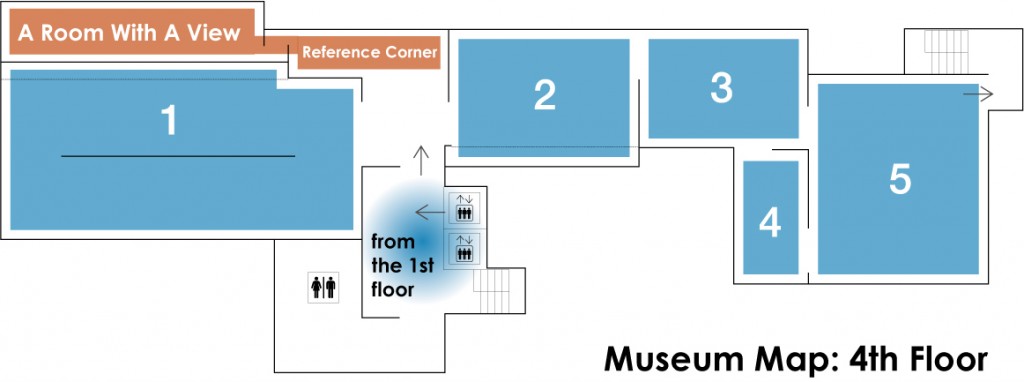
Room 1 Highlights * This section presents a consolidation of splendid works from the collection, with a focus on Master Pieces.
Room 2– 5 1900s-1940s
From the End of the Meiji Period to the Beginning of the Showa Period
A Room With A View
Reference Corner
Room 1 Highlights
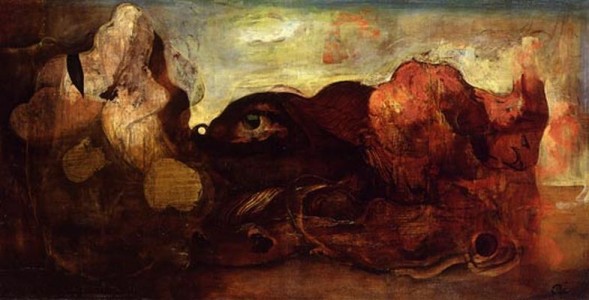
The MOMAT Collection, drawn from the museum’s holdings, consists of over 200 works displayed over a 3,000-square meter area. To start off the exhibition, we present the Highlights section, consisting of some of the collection’s most essential works, including Important Cultural Properties. For the walls of this newly established space (part of a 2012 effort to renovate the collection galleries), we have selected navy blue to create a more beautiful contrast with the works. And to eliminate the glare of glass cases, we have chosen mat black for the floor.
This year marks the 150th anniversary of start of the Meiji Period (1868-1912). To commemorate this historical landmark, we present Kaburaki Kiyokata’s Monthly Manners and Customs of the Meiji Period during the first part of the exhibition (June 5-July 29). As you examine the details of the work, please imagine how people of the era lived. In the second part of the exhibition (July 31-September 24), we present Kawabata Ryushi’s Flaming Grass and Kobayashi Kokei’s Indian Corn Plants in keeping with the season. Although all of the motifs are summer plants, the depictions are resplendent with unique characteristics.
In the yo-ga (Western-style paintings by Japanese artists) exhibit, we present a number of important works from the Meiji to the early Showa Period (1926-1989), including Harada Naojiro’s Kannon Bodhisattva Riding the Dragon and Nakamura Tsune’s Portrait of Vasilii Yaroshenko. Koga Harue’s Sea contains a scattering of suitably seasonal images as well as a refined composition.
Room 2 The Melancholy of the Countryside
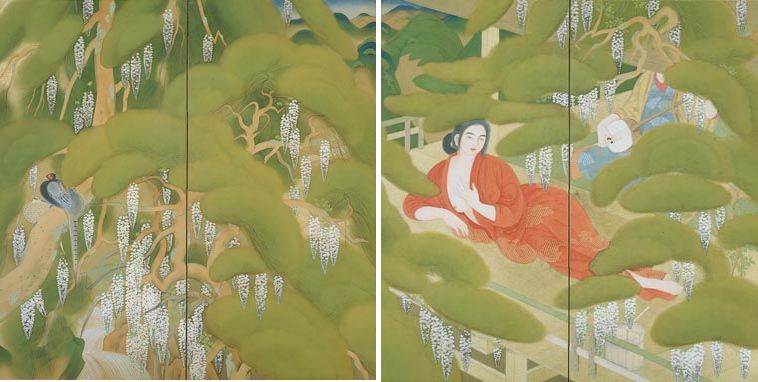
This year marks the 150th anniversary of the Meiji Period, but what kind of year was 1918, which occurred exactly 100 years ago? Although 1918 was a year of important historical landmarks, such as the end of the First World War, we are going to focus on a relatively minor event. Sato Haruo’s novel The Melancholy of the Countryside was also published that year.
The book meticulously depicts the mental workings of the protagonist, who, having grown weary of city life, moves to a secluded house in the suburbs surrounded by greenery. After reading the story and looking at art of the period, you realize that there is no shortage of works that deal with people lingering in plant-filled spaces and suburban scenes. For example, there is a splendid resonance between Murayama Kaita’s Roses and a Girl and the original title of Sato’s novel, The Sick Rose. The Taisho Period (1912-1926) is often seen as an era that placed a strong emphasis on individuality and the self, but there were also plenty of self-aware individuals who were tormented by social friction. Perhaps these plant-encircled areas were envisioned by artists of the era as a kind of Utopia to help them recover from exhaustion.
Room 3 A Friendship Formed in Paris
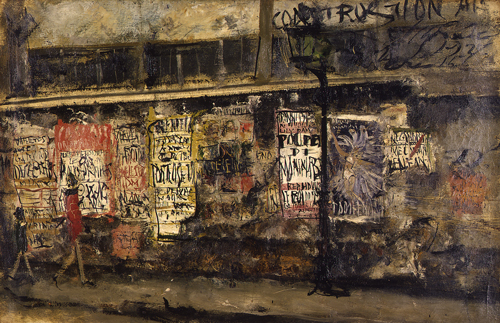
Following the First World War, there was a dramatic increase in the number of Japanese painters who went to study in Paris. After pursuing a variety of styles based on their individual interests, they returned to Japan with their newfound knowledge. In 1926, five of these artists, Maeta Kanji, Satomi Katsuzo, Saeki Yuzo, Kojima Zentaro, and Kinoshita Takanori, formed the 1930 Society. Their main motivations were to continue the friendships they had formed in Paris and to show the work they had created while living there. Other artists whom they had associated with in France also joined the group on their return to Japan, expanding the membership. Since their bonds were based on friendship, the artists’ styles were highly varied, as suggested by the works on display in this room. But the most important thing they learned in Paris was not style, it was the artistic approach of giving top priority to a subjective vision. Exaggerating things that they viewed as real based on a personal sensibility lay at the root of this new Realism. The fact that each artist’s style was so disparate enhanced the overall allure of the group as a collection of individuals. This also attracted younger artists who were searching for new forms of expression.
Room 4 Koizumi Kishio, Works from One Hundred Scenes from the Tokyo Metropolis in the Showa Period
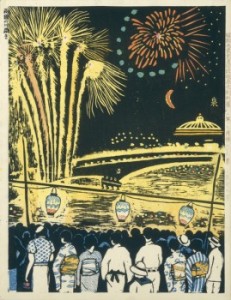
(Exhibit Date: June 5 – July 29)
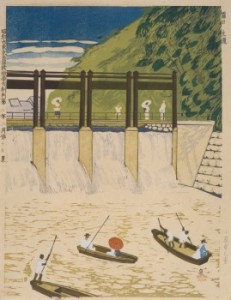
(Exhibit Date: July 31 – September 24)
Born in Shizuoka, Koizumi Kishio moved to Tokyo in 1909 and studied at the Japan Institute of Watercolor Painting, which was overseen by Oshita Tojiro. After became acquainted with Tobari Kogan and Oda Kazuma at the school, Koizumi began making prints. Between the late Meiji and the early Taisho era, prints became established as an art form rather than merely a reproductive technique for practical applications. As a print artist, Koizumi followed in the footsteps of the Creative Print movement, which was based on the idea that an artist would make his or her own picture, carve the plate, and print the work without relying on an artisan.
One of Koizumi’s most prominent works, One Hundred Scenes from the Tokyo Metropolis in the Showa Period (published in pieces from 1929 to 1937) is an outstanding print series depicting the restoration and modernization of Tokyo in the wake of the 1923 Great Kanto Earthquake. Unsatisfied with the final product, Koizumi later revised some of the prints, creating a total of 105 works, 57 of which are contained in the museum collection. The works are distinguished by simple and concise compositions, and bright and vivid colors that make the most of the watercolor paint. In addition to sights that had been famous since the ukiyoe era, the prints depict scenes of Tokyo, which are striking for the urbanization, industrialization, and commercialization brought about by post-earthquake restoration, and the daily lives of people in the city. The works approach these beautiful, geometrical urban forms and modern manners and customs with a detached perspective.
Room 5 Animals and the War Era
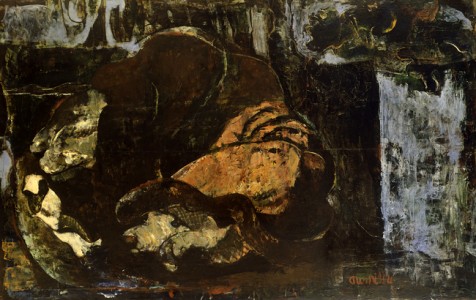
When a society heads into war, people are not the only ones who get caught in the middle. During the Pacific War, animals were mobilized to transport goods and slaughtered in the fear that they would escape in the chaos caused by air raids. This might remind some viewers of the poor elephants depicted in Tsuchiya Yukio’s picture book Faithful Elephants: A True Story of Animals, People, and War.
Most war-record paintings depict soldiers on the front lines or their families on the home front, but many other artists dealt with the theme of animals during this period. For example, images of fierce horses and eagles preparing to take flight were probably intended to increase the fighting spirit. Maple seedpods often appear in Kitawaki Noboru’s work as a metaphor for airplanes or jet fighters. Ai-Mitsu’s small, scrunched up lion seems to suggest people who were unavoidably engulfed in the tumult of the era.
3F (Third floor)

Room 6-8 1940s-1960s
From the End of the Meiji Period to the Beginning of the Showa Period
Room 9 Photography and Video
Room 10 Nihon-ga (Japanese-style Painting)
Room to Consider the Building
Room 6 Restless Bodies
At a time when the aftereffects of the Pacific War were still very pronounced, a variety of artists made works depicting introspective and depressed people as a way of quietly expressing their opposition to the turbulent social conditions.
Kazuki Yasuo was interned in Siberia after the war. After being sent home, he adopted a completely different artistic style, focusing on people who had suffered at the hands of society. These works might also be seen as self-portraits of a grief-stricken artist who fell victim to harsh circumstances.
Aso Saburo and Suguro Tadashi’s works portray people who are being crushed by things in a small space. While both Oyamada Jiro and Nakano Jun make use of dining tables, the artists fill the canvas with vivid brushstrokes, depicting dark scenes that are far removed from the pleasure of eating and enjoying each other’s company. The gloomy expressions and fragmented lifeless bodies reflect the atmosphere in a society faced with the reality that life is interchangeable.
Room 7 2018-50=1968
This room consists entirely of works made in 1968. Today, the year is associated with the “season of politics,” but needless to say, not everything was political at the time. For example, one thing that attracted a great deal of interest was UFOs. So much so that a hearing on the subject (commonly known as the UFO Symposium) was held in the U.S. House of Representatives. UFOs appeared in manga of the period too. This was also the year of the so-called Anpo Protests (the student movement reached a fever pitch around the same time), designed to block the automatic extension of the Japan-U.S. Security Treaty in 1970. Under the circumstances, any artist who evoked America in their work might seem to have been supporting the protests, but this was apparently not always the case.
Room 8 The 1970s: There Are Only Women in This Room
As it turns out, there is only a single female artist in the preceding seven rooms. This demonstrates the distorted nature of the museum collection. With this in mind, we decided to, at the very least, devote this room entirely to women (through September 24). In Japan and elsewhere, the ’70s were a period in which women’s activities became clearly visible (or began to receive proper recognition). This was partly due to social factors. For example, in 1975 the United Nations designated the following ten years as the International Women’s Year and called on every country and organization to set establish goals and act accordingly. This led the Japanese government to formulate to a plan of action in 1977.
Room 9 – 1 Yamamura Gasho, Plants (Exhibit Date: June 5 – July 29)
In this exhibit, we feature Yamamura Gasho’s Plants. The series, made up of monochrome works in which Yamamura trained his lens on scenes of thick vegetation, such as bushes, trees, and flowers, embodies a unique artistic vision markedly different from standard nature or landscape photography. In keeping with the artist’s stated intention of capturing “the various ecologies of plants dwelling in the darkness” (as Yamamura commented in the April 1976 issue of Camera Mainichi), the vegetation in his photographs exudes a strange quality, accentuated by his use of strobes in daylight and high-contrast printing.
Yamamura’s early work, The Children Living in Washington Heights (1959-62), which earned him a great deal of acclaim while still in university, focuses on the strange world of children living in U.S. Army housing in the middle of Tokyo. As this series suggests, the artist has shown a consistent interest in unknown realms and extraordinary entities living alongside familiar scenes. Plants depicts the strange appearance of vegetation that is at once familiar but is also often viewed with indifference as something alien. This important series unifies Yamamura’s, an artist whose talent flowered early, artistic direction and photographic technique.
Room 9 – 2 Hosoe Eikoh, Ordeal by Roses (Exhibit Date: July 31 – September 24)
These 11 works are from Ordeal by Roses, an early work by Hosoe Eikoh in which he explored fundamental themes of human existence such as life, death, and eros using the motifs of the novelist Mishima Yukio’s body and his idiosyncratic aesthetic sensibility.
Impressed by Hosoe’s pictures of the butoh dancer Hijikata Tatsumi (published in a photo book called Man and Woman), Mishima selected the photographer to take a portrait that was used to adorn a collection of the writer’s criticism. In the garden of Mishima’s house, where the shoot took place, Hosoe employed drastic staging such as wrapping a rubber water hose around Mishima’s naked torso. Deeply satisfied with these brilliant and highly finished works, Mishima agreed to Hosoe’s request for an additional shoot. Taken over a period of about two years, the resulting works were published in the 1963 photo book Ordeal by Roses.
Hosoe’s genius lay in his ability to identify the perverted impulses to suffer and self-destruct that were concealed within Mishima, who proudly displayed his physical beauty, and to use a variety of settings to illuminate these qualities. This aim was embodied by the beautiful but thrown-encrusted rose motif. The title Ordeal by Roses was devised by Mishima, the key player in this bizarre artistic world.
Room 10 Special Exhibit: Art in the Late Meiji Period
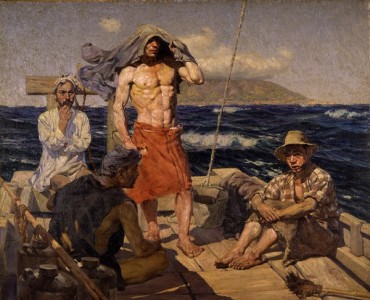
The museum primarily deals with art after the Bunten, an annual Ministry of Education-sponsored exhibition that was launched in 1907. This year, to commemorate the 150th anniversary of the Meiji Period, we feature a number of works from the collection that date from that era.
In a surge of Westernization, Japan underwent a sudden modernization, which also had a strong effect on the art world. As part of the influx of Western-style painting, artists searched for new types of expression as seen in Wada Sanzo’s South Wind, which depicts figures with dynamic and characteristically unJapanese physiques. At the same time, in Nihonga, the traditional form of Japanese-style painting, artists blurred contours to create a three-dimensional effect and developed other experimental methods in their search for originality.
In addition to Nihonga and Western-style painting, in this special exhibit, we focus on the rich world of art that emerged in the late Meiji Period with sculptures and outstanding watercolor paintings, such as Oshita Tojiro’s Foot of Mt. Hotaka (on view until July 29) and Yoshida Hiroshi’s Crescent (on view from July 31). We also present paintings such as Yorozu Tetsugoro’s Nude Beauty to illustrate the links to the subsequent Taisho Period, in which works that emphasized the artist’s individuality came to the fore.
2F (Second floor)
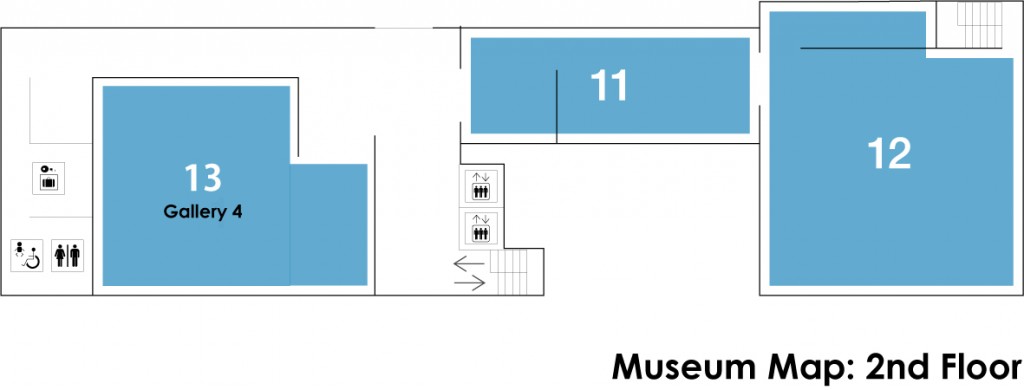
Room 11-12 1970s-2010s
From the End of the Showa Period to the Present
Gallery 4
* A space of about 250 square meters. This gallery offers cutting-edge thematic exhibitions from the Museum Collection, and special exhibitions featuring photographs or design.
Takiguchi Shuzo and the Artists Who Captivated Him
Primarily from the Museum Collection
Room 11 Are Faces Really Necessary?
As suggested by the development of facial recognition systems, faces are often seen as a way of differentiating between one person and another. Or, as is vividly expressed by a phrase like “It’s written all over your face,” faces are believed to convey a person’s inner state through an expression or change in color. Due especially to this function, artists have used a variety of methods to incorporate faces into their work. In some cases, they have created compositions that call attention to the face or made works with only a detached face (or head). While some have made a concentrated effort to deal with the shape of the face by giving it an impassive expression, others have attempted to convey the idea that a person’s inner workings can be expressed without depicting the face. In this group of works, most of which were made since the 1990s, we examine how artists deal with facial expressions.
Room 12 Welcome, Mr. Smith
Last year the museum acquired Circle IV (1962) by David Smith, a prominent postwar sculptor. To commemorate this, we present a collection of paintings and sculptures that are designed to deepen your understanding of the work. These include a work that attempts to fuse painting and sculpture, a work that uses an abstract expression to depict the human body, a work that focuses on the labor required to make sculpture, and a more straightforward work based on a circle motif. The fact that a single work can summon up such a wide variety of expressions shows that even though they might seem indifferent, art works are imbued with any number of concepts.
About the Exhibition
- Location
-
Collection Gallery, from the fourth to second floors
- Date
-
June 5 – September 24, 2018
- Time
-
10:00 – 17:00 (10:00 – 20:00 on Fridays and Saturdays)
MOMAT Collection and Gallery 4 open until 21:00 on Fridays and Saturdays during Gordon Matta-Clark: Mutation in Space (June 19 – September 17)
*Last admission is 30 minutes before closing. - Closed
-
※Closed on Mondays (except July 16, September 17 and 24), July 17 and September 18
- Admission
-
Adults ¥500 (400)
College and university students ¥250 (200)
*The price in brackets is for the group of 20 persons or more. All prices include tax.
Free for high school students, under 18, seniors( 65 and over ), Campus Members, MOMAT passport holder.
*Show your Membership Card of the MOMAT Supporters or the MOMAT Members to get free admission ( a MOMAT Members Card admits two persons free ).
*Persons with disability and one person accompanying them are admitted free of charge.
*Members of the MOMAT Corporate Partners are admitted free with their staff ID. - Discounts
-
Evening Discount (From 17:00 on Fridays and Saturdays)
Adults ¥300
College and university students ¥150
*Admission free for college and university students from 17:00 on Fridays and Saturdays between June 19 and September 17. - Free Admission Days
-
Collection Gallery and Gallery 4
Free on the first Sunday of each month (July 1, August 5 and September 2). - Organized by
-
The National Museum of Modern Art, Tokyo


